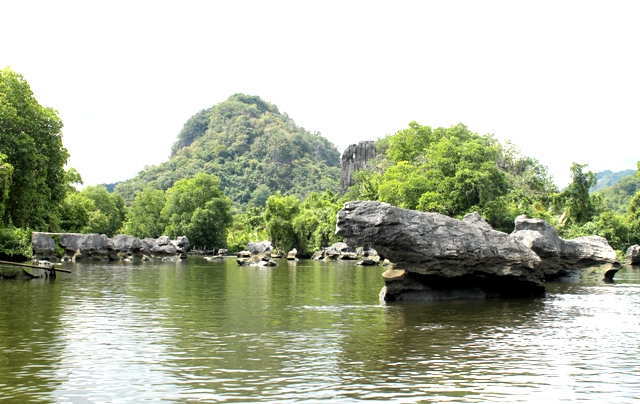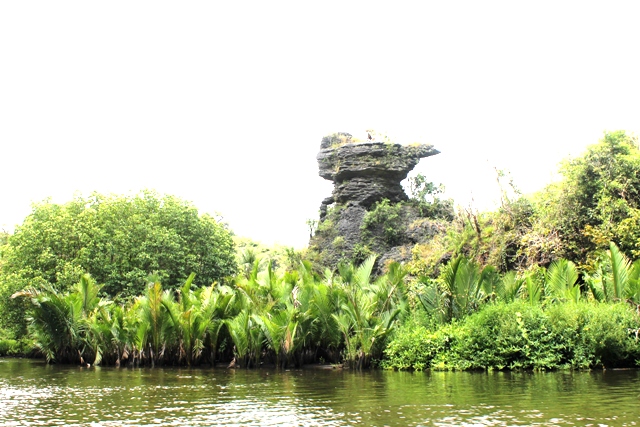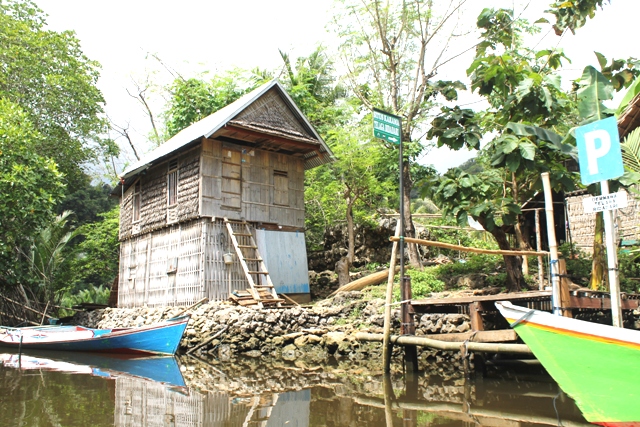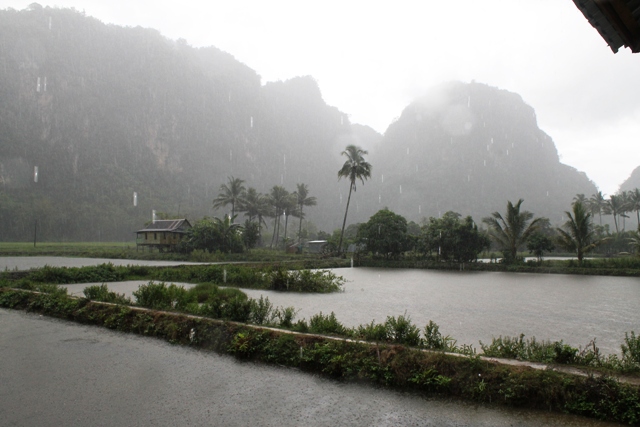Indonesia has three karst regions: in Bantimurung and Rammang Rammang, both are situated in Maros Regency, South Sulawesi and in Mt. Sewu in Java.

How can I explain about karst while I am not a geologist? The simplest way I can tell is the example of the landscape in Ha Long Bay and Tam Cốc-Bích Động in Viet Nam. Those are the example of karst landscape. Anybody who has traveled to those places gets a picture what the land of karst is. Indeed, the karst landscape offers lovely natural panorama.
The karst landscape is geologically formed by the dissolution of soluble rocks such as limestone and dolomite. It contains underground layers, which are able to provide large supplies of ground water and springs. As such, the karst region is featured by the caves and springs.
Rammang Rammang, Maros, South Sulawesi
I recently visited Rammang Rammang, about 40 kilometer in the north of the province’s capital, Makassar. The ride from Makassar to Rammang Rammang takes about two hours. After passing Maros City, the capital of Maros Regency, the ride offers a scenic view of rice field and karst mountains as the background.
Rammang is a local dialect which means fog or cloud. This is because in this karst area the fog usually hovers in the morning or when it is raining.
The best way to explore the karst area in Desa Salenrang is by boat through Pute River. The boat will take you from the Dock 1 Salenrang to Desa Berua. In Desa Berua you can get a nice view of karst mountain in a village setting.

The local community operates boats for visitors who want explore the karst region by the boat. The first dock is Dermaga/Dock 1 Salenrang. This is where most visitors get on the boat. There is a sign from the main road directing to the dock.
The maximal capacity of one motor boat is 10 people. Don’t worry about the price, there is a paper describing the rental price for the boat, so no need to bargain. If you don’t bring the hat with you, you can rent the hat for Rp 10,000.

As soon we are on the boat, the boat man starts the engine and the boat moves along Pute River. The karst in Rammang Rammang covers around 45 square kilometer area. The karst also spreads on the river so only local man can drive the boat, who recognizes the site exactly.

I can say that the river water is shallow and turbid. The marsh vegetation like Nypa and mangroves grow along the shore. Those trees are not so tall so the river is not shaded. As the sky is open, I can clearly see the karst walls protrude here and there as we are moving along the river. That is the interesting part of this boat ride, besides seeing some caves.

Other than Dock 1, there are other two docks where visitors can board the boat. Along the river, we can spot some houses of the villagers with their cattle.

The boat stopped at Kampung Berua. The distance between the Dock 1 to Kampung Berua is about 3 kilometers. The local community asks for a fee for entrance. They provide a log book to register the visitors.

At a glance, the view of the village reminds me to a view in the karst area of Tam Cốc-Bích Động in Viet Nam. The village is surrounded by the walls of karst mountains. The paddy rice fields and stilted houses add to the natural atmosphere of a village life. The best time to visit the village is during the daylight as the contrast between blue sky and greenery gives a refreshing effect to the eyes.

Our boat will wait as long as we are in the Berua before going back to the Dock. After raining, some paths in the village can be muddy and slippery, you need to be careful when you want to explore the village after the rain. There is a cave you can visit passing the muddy paths of the rice field and some sites if you like trekking.

Rammang Rammang Karst, Maros, South Sulawesi
Location: Desa Salenrang, Jalan Poros Maros-Pangkep km 9.5, Kecamatan Bontoa, Kabupaten Maros, Provinsi Sulawesi Selatan.
How to get there:
- From Makassar it takes approximately two hours. It is recommended to rent a car if you come in a group of 2-4 people. The car rental with driver is about Rp 600,000-Rp 650,000 per 12 hours.
- By public transportation
· From Makassar, Terminal Daya, take pete pete, a colt like public vehicle, to Maros.
· From Maros, take pete pete to Pangkep, get out at the Pertigaan Pabrik Semen Bosowa. Make sure to the driver that he drives until Pangkep and tell him you are going to Rammang Rammang.
· Take motorcycle taxi/ojek to the dock
· The boat rental costs
1 to 4 persons Rp 200,000
5 to 7 persons Rp 250,000
8-10 persons Rp 300,000
The entrance fee to Kampung Berua Rp 10,000/person
- Makassar has an international airport that is well connected with Jakarta, Singapore, Kuala Lumpur Malaysia and other big cities in Indonesia.
Tips:
- Dress code: long sleeve tshirt, sunglass, hats, good walking shoes
- Bring your own food since there is no food vendor around
- Bring raincoat just in case
How to Improve Rammang Rammang, Maros, South Sulawesi
Kampung/Village Berua is potentially developed into a tour destination. But I must admit it should be professionally managed. With the increasing number of visitors comes to this place, some infrastructures need to be provided and built.
1. Trash bins
In touristic areas such as in the beach, waterfalls, mountains, woods, museums and rivers, the basic problem is the trash. People just dispose their trash anywhere. Only few developed touristic destination provide trash bins in enough numbers. The villagers need to provide trash bins in the spots where tourists usually visit. They also need to empty these trash bins and process the trash in a green way.
In the nearby cave, I didn’t see any trash bins, and again the plastics and papers are scattered.
I can also see the trashes like the plastics, paper cups, cigarette butts are scattered nearby the food vendor. This is really in contrast with the surrounding nature.
2. Toilette
Kampung Berau has toilettes for visitors unfortunately they are not well maintained. It is too small, no lighting inside and the lock is broken, sorry to say.
3. Stoned paveway
When I visited Kampung Berua it was about to rain. After the rain the soil became so muddy. The lack of stoned pave way in the toilette area and small hawker makes the area so dirty after the raining.


4. Natural and local architecture
I am glad to see an open stilted house that looks like it is recently built. The visitors can use the silted house to sit or eat. If more houses are to be built, it should better have local flavor.
I need to point these out as Rammang Rammang offers natural beauty more people should enjoy. And the infrastructures are necessary to sustain the place. People will not come to see dirty, messy and unorganized places. Believe me! And the word-of-mouth marketing usually works better.

